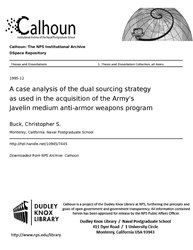File:A case analysis of the dual sourcing strategy as used in the acquisition of the Army's Javelin medium anti-armor weapons program (IA acasenalysisofdu109457445).pdf

Original file (1,275 × 1,650 pixels, file size: 23.21 MB, MIME type: application/pdf, 109 pages)
Captions
Captions
Summary[edit]
| A case analysis of the dual sourcing strategy as used in the acquisition of the Army's Javelin medium anti-armor weapons program
( |
||
|---|---|---|
| Author |
Buck, Christopher S. |
|
| Title |
A case analysis of the dual sourcing strategy as used in the acquisition of the Army's Javelin medium anti-armor weapons program |
|
| Publisher |
Monterey, California. Naval Postgraduate School |
|
| Description |
The use of competition during the acquisition of major weapon systems is a key ingredient to mitigating risk and reducing total program costs, One tool the program manager (PM) has at his disposal to ensure competition is viable is dual sourcing. Since the 1960's, PMs have continuously considered the advantages and disadvantages of dual sourcing when developing their acquisition strategy. However, in the past few years dual sourcing as an overall program strategy has come close to being abandoned. Sole source procurement, especially in the production phase of major weapon systems, has returned as the norm. It appears the cause for this can be directly traced to the large force drawdowns, reduced budgets and decreased quantity requirements of the 1990's. The Army's Javelin program, which began in the 1980's, developed its acquisition strategy around the use of dual sourcing. Dual sourcing within this program has focused both on the overall program level (macro) and at the subcomponent level (micro). The lessons learned and techniques used in this program may provide useful insight for other PMs considering the use of dual sourcing, or within programs facing budget cuts or program downsizing. Subjects: |
|
| Language | English | |
| Publication date |
December 1995 publication_date QS:P577,+1995-12-00T00:00:00Z/10 |
|
| Current location |
IA Collections: navalpostgraduateschoollibrary; fedlink |
|
| Accession number |
acasenalysisofdu109457445 |
|
| Source | ||
| Permission (Reusing this file) |
This publication is a work of the U.S. Government as defined in Title 17, United States Code, Section 101. As such, it is in the public domain, and under the provisions of Title 17, United States Code, Section 105, may not be copyrighted. | |
Licensing[edit]
| Public domainPublic domainfalsefalse |
This work is in the public domain in the United States because it is a work prepared by an officer or employee of the United States Government as part of that person’s official duties under the terms of Title 17, Chapter 1, Section 105 of the US Code.
Note: This only applies to original works of the Federal Government and not to the work of any individual U.S. state, territory, commonwealth, county, municipality, or any other subdivision. This template also does not apply to postage stamp designs published by the United States Postal Service since 1978. (See § 313.6(C)(1) of Compendium of U.S. Copyright Office Practices). It also does not apply to certain US coins; see The US Mint Terms of Use.
|
 | |
| This file has been identified as being free of known restrictions under copyright law, including all related and neighboring rights. | ||
https://creativecommons.org/publicdomain/mark/1.0/PDMCreative Commons Public Domain Mark 1.0falsefalse
File history
Click on a date/time to view the file as it appeared at that time.
| Date/Time | Thumbnail | Dimensions | User | Comment | |
|---|---|---|---|---|---|
| current | 20:13, 13 July 2020 |  | 1,275 × 1,650, 109 pages (23.21 MB) | Fæ (talk | contribs) | FEDLINK - United States Federal Collection acasenalysisofdu109457445 (User talk:Fæ/IA books#Fork8) (batch 1993-2020 #5061) |
You cannot overwrite this file.
File usage on Commons
The following page uses this file:
Metadata
This file contains additional information such as Exif metadata which may have been added by the digital camera, scanner, or software program used to create or digitize it. If the file has been modified from its original state, some details such as the timestamp may not fully reflect those of the original file. The timestamp is only as accurate as the clock in the camera, and it may be completely wrong.
| Short title | A case analysis of the dual sourcing strategy as used in the acquisition of the Army's Javelin medium anti-armor weapons program |
|---|---|
| Author | Buck, Christopher S. |
| Date and time of digitizing | 05:31, 21 June 2012 |
| Software used | EPSON GT-S80 |
| File change date and time | 05:40, 21 June 2012 |
| Date metadata was last modified | 05:40, 21 June 2012 |
| Conversion program | Adobe Acrobat 9.51 Paper Capture Plug-in |
| Encrypted | no |
| Page size |
|
| Version of PDF format | 1.4 |

